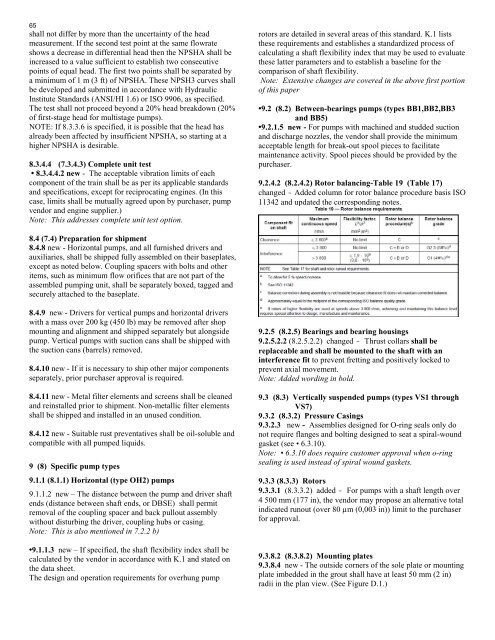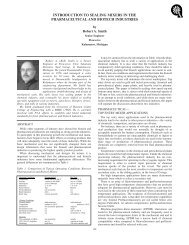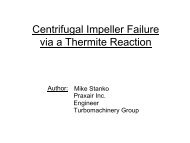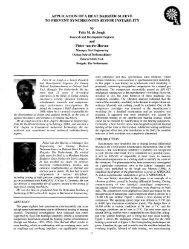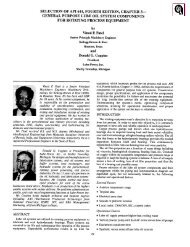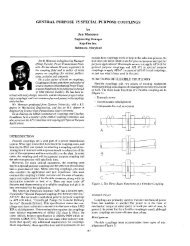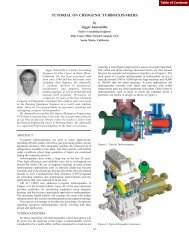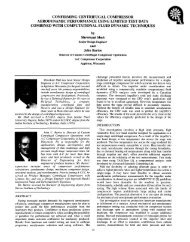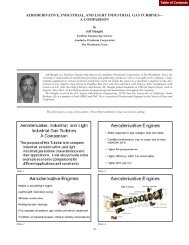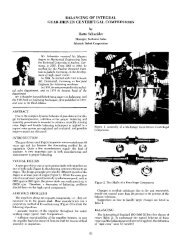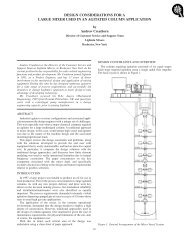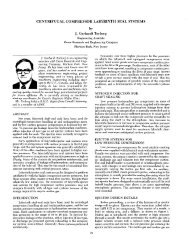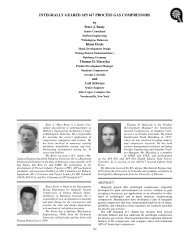ISO 13709 2nd Edition/ API 610 Eleventh Edition Highlights
ISO 13709 2nd Edition/ API 610 Eleventh Edition Highlights
ISO 13709 2nd Edition/ API 610 Eleventh Edition Highlights
Create successful ePaper yourself
Turn your PDF publications into a flip-book with our unique Google optimized e-Paper software.
65<br />
shall not differ by more than the uncertainty of the head<br />
measurement. If the second test point at the same flowrate<br />
shows a decrease in differential head then the NPSHA shall be<br />
increased to a value sufficient to establish two consecutive<br />
points of equal head. The first two points shall be separated by<br />
a minimum of 1 m (3 ft) of NPSHA. These NPSH3 curves shall<br />
be developed and submitted in accordance with Hydraulic<br />
Institute Standards (ANSI/HI 1.6) or <strong>ISO</strong> 9906, as specified.<br />
The test shall not proceed beyond a 20% head breakdown (20%<br />
of first-stage head for multistage pumps).<br />
NOTE: If 8.3.3.6 is specified, it is possible that the head has<br />
already been affected by insufficient NPSHA, so starting at a<br />
higher NPSHA is desirable.<br />
8.3.4.4 (7.3.4.3) Complete unit test<br />
• 8.3.4.4.2 new - The acceptable vibration limits of each<br />
component of the train shall be as per its applicable standards<br />
and specifications, except for reciprocating engines. (In this<br />
case, limits shall be mutually agreed upon by purchaser, pump<br />
vendor and engine supplier.)<br />
Note: This addresses complete unit test option.<br />
rotors are detailed in several areas of this standard. K.1 lists<br />
these requirements and establishes a standardized process of<br />
calculating a shaft flexibility index that may be used to evaluate<br />
these latter parameters and to establish a baseline for the<br />
comparison of shaft flexibility.<br />
Note: Extensive changes are covered in the above first portion<br />
of this paper<br />
•9.2 (8.2) Between-bearings pumps (types BB1,BB2,BB3<br />
and BB5)<br />
•9.2.1.5 new - For pumps with machined and studded suction<br />
and discharge nozzles, the vendor shall provide the minimum<br />
acceptable length for break-out spool pieces to facilitate<br />
maintenance activity. Spool pieces should be provided by the<br />
purchaser.<br />
9.2.4.2 (8.2.4.2) Rotor balancing-Table 19 (Table 17)<br />
changed - Added column for rotor balance procedure basis <strong>ISO</strong><br />
11342 and updated the corresponding notes.<br />
8.4 (7.4) Preparation for shipment<br />
8.4.8 new - Horizontal pumps, and all furnished drivers and<br />
auxiliaries, shall be shipped fully assembled on their baseplates,<br />
except as noted below. Coupling spacers with bolts and other<br />
items, such as minimum flow orifices that are not part of the<br />
assembled pumping unit, shall be separately boxed, tagged and<br />
securely attached to the baseplate.<br />
8.4.9 new - Drivers for vertical pumps and horizontal drivers<br />
with a mass over 200 kg (450 lb) may be removed after shop<br />
mounting and alignment and shipped separately but alongside<br />
pump. Vertical pumps with suction cans shall be shipped with<br />
the suction cans (barrels) removed.<br />
8.4.10 new - If it is necessary to ship other major components<br />
separately, prior purchaser approval is required.<br />
8.4.11 new - Metal filter elements and screens shall be cleaned<br />
and reinstalled prior to shipment. Non-metallic filter elements<br />
shall be shipped and installed in an unused condition.<br />
8.4.12 new - Suitable rust preventatives shall be oil-soluble and<br />
compatible with all pumped liquids.<br />
9 (8) Specific pump types<br />
9.1.1 (8.1.1) Horizontal (type OH2) pumps<br />
9.1.1.2 new – The distance between the pump and driver shaft<br />
ends (distance between shaft ends, or DBSE) shall permit<br />
removal of the coupling spacer and back pullout assembly<br />
without disturbing the driver, coupling hubs or casing.<br />
Note: This is also mentioned in 7.2.2 b)<br />
•9.1.1.3 new – If specified, the shaft flexibility index shall be<br />
calculated by the vendor in accordance with K.1 and stated on<br />
the data sheet.<br />
The design and operation requirements for overhung pump<br />
9.2.5 (8.2.5) Bearings and bearing housings<br />
9.2.5.2.2 (8.2.5.2.2) changed - Thrust collars shall be<br />
replaceable and shall be mounted to the shaft with an<br />
interference fit to prevent fretting and positively locked to<br />
prevent axial movement.<br />
Note: Added wording in bold.<br />
9.3 (8.3) Vertically suspended pumps (types VS1 through<br />
VS7)<br />
9.3.2 (8.3.2) Pressure Casings<br />
9.3.2.3 new - Assemblies designed for O-ring seals only do<br />
not require flanges and bolting designed to seat a spiral-wound<br />
gasket (see • 6.3.10).<br />
Note: • 6.3.10 does require customer approval when o-ring<br />
sealing is used instead of spiral wound gaskets.<br />
9.3.3 (8.3.3) Rotors<br />
9.3.3.1 (8.3.3.2) added - For pumps with a shaft length over<br />
4 500 mm (177 in), the vendor may propose an alternative total<br />
indicated runout (over 80 µm (0,003 in)) limit to the purchaser<br />
for approval.<br />
9.3.8.2 (8.3.8.2) Mounting plates<br />
9.3.8.4 new - The outside corners of the sole plate or mounting<br />
plate imbedded in the grout shall have at least 50 mm (2 in)<br />
radii in the plan view. (See Figure D.1.)


